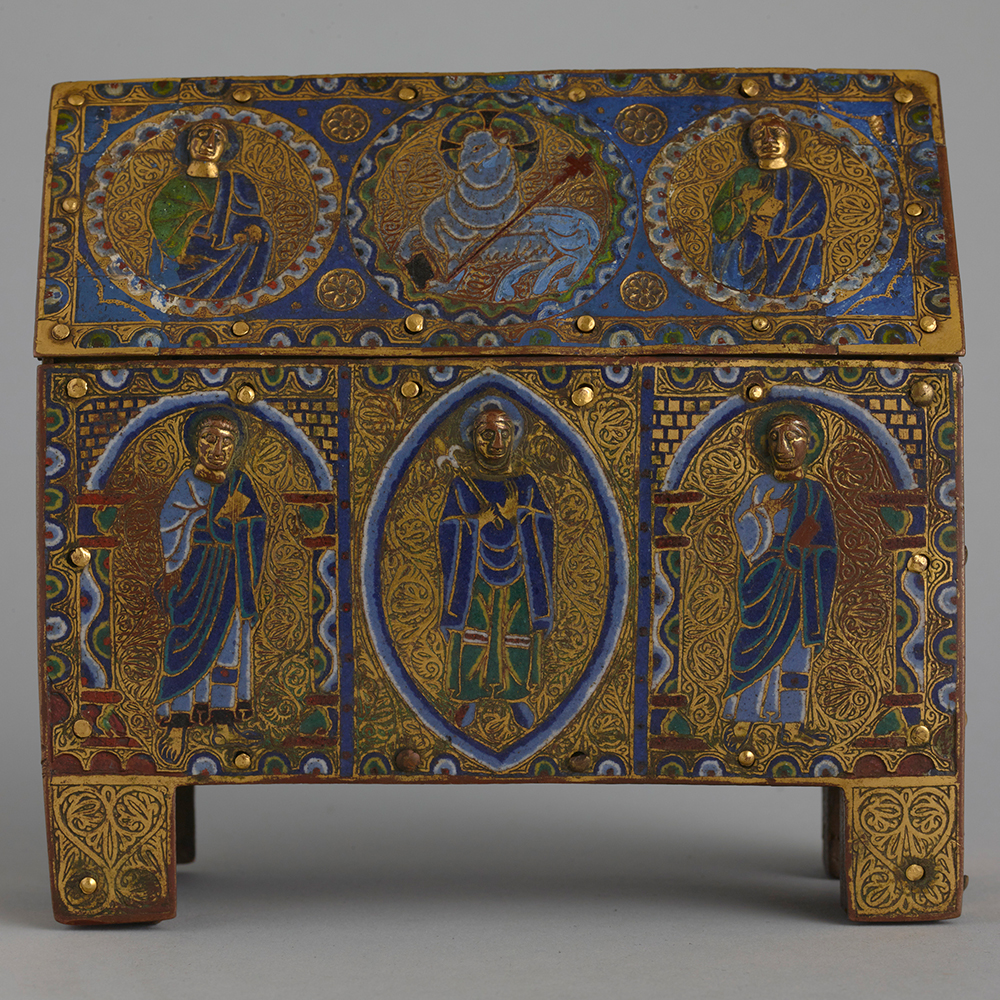Vermicular Chasse with Saints and the Lamb of God

c.1185
Present-day France (Limoges)
Copper, gilt copper, champlevé enamel, wood core
Height: 5.5 in (14.1 cm)
Wyvern Collection, 0436
During the twelfth and thirteenth centuries, small towns in south-west- central France merged, flourished, and became known as the diocese and county of Limoges. To demonstrate their piety, monarchs and monasteries from many regions of Europe patronized the enamel workshops of Limoges that manufactured precious objects for ecclesiastical services, and reliquaries that contained the physical remains of saints or objects associated with those holy figures. The Wyvern Limoges chasse provides an example of the forms and techniques typical of Limoges reliquaries from the late twelfth and thirteenth centuries (see cat. 40). The workshops at Limoges employed the technique of champlevé enameling, in which small recesses are carved into the surface of a copper plate and filled with enamel (ground colored glass). The plate is fired at about 1000 degrees Celsius to melt the enamel and fuse it to the metal plate. The uncarved parts would later be gilded and polished. This example also includes vermiculé decoration, with a series of fine, curving lines covering the metal surfaces (from the Latin word vermiculus, meaning “little worm”). Originally known as opus lemovicense—work from Limoges— these mass-produced enamels follow a fairly consistent format, combining Christian iconography with floral and geometric design.
Typical of Limoges work from this period, the workshop that produced the Wyvern Vermicular Chasse first created six separate panels and then nailed these to a wooden core. Many such works did not feature a specific narrative, instead depicting standing saints, some with distinguishing attributes and others, as here, looking like generic stock characters. Five of the heads were manufactured separately and attached, an appliqué feature common in Limoges works (see cat. 35). (1) All eight feature a blue halo ornamented with flecks of color. On the front face of the container, a central figure is enclosed by a blue mandorla, an oval full-body halo. His clothing and shoes differentiate him from the two flanking figures, and suggest, along with his staff, that he is a clerical figure— a priest or bishop. On the angled upper panel on the front of the chasse, an undulating ring frames an Agnus Dei, the Lamb of God, who wears a halo, carries a Gospel book, and wields a martyr’s cross. To either side of the Lamb, circular frames enclose half-length figures. The end panels depict single standing figures, both barefoot, one bearded, the other clutching a book and a scroll.
On the back of the reliquary, a geometric pattern of pale blue and green florets or crosses, each circled in a gold and blue frame, are interspersed with smaller crosses. The back panels are fully enameled with a solid field of blue, whereas the front and side panels are gilt and engraved with swirling vermiculé. The alternating color patterns and figure sequences suggest a particular attention to balance, hierarchy, and harmony. From rusted black to shiny brass, the condition of the nails varies greatly, indicating repair. Corrosion along the edge of several of the panels signals the age of the object, and on the back an entire floret is missing, exposing the weathered copper beneath.
Maria McCarthy, Class of 2020
Notes
- O’Neill 1996, p. 54